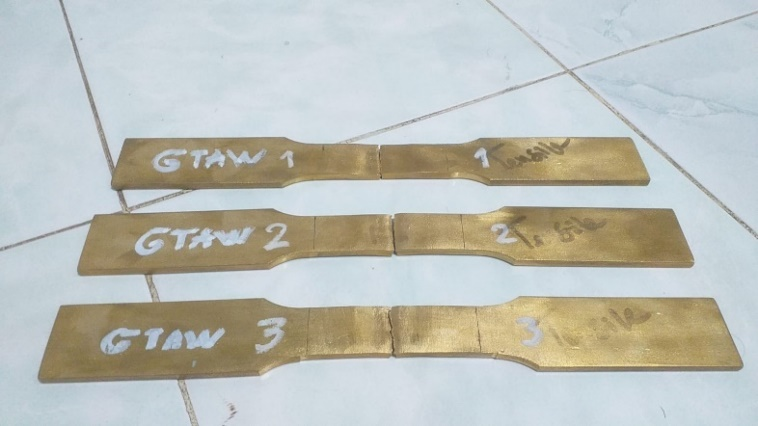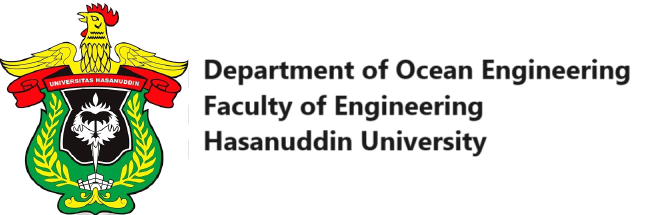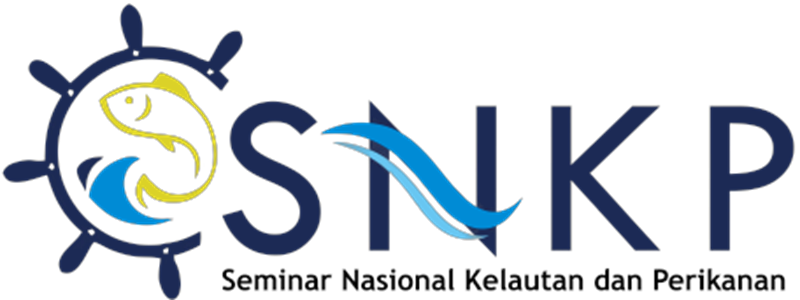Gas Tungsten Arc Welding (GTAW) and Underwater Welding (UW) on Brass Propeller Repairs
DOI:
https://doi.org/10.62012/zl.v5i1.32960Keywords:
Propeller, Gas Tungsten Arc Welding, Underwater WeldingAbstract
Over time, marine building technology has experienced very significant developments and there are several variations of improvements that can be made to suit needs and conditions. A ship's propeller is a ship component that often experiences collisions with hard objects floating in the water which can cause the blades of the propeller to experience damage such as bending, cracking or breaking. In this case, the propeller should be repaired immediately so as not to disrupt the smooth operation of the ship. Repairing broken propeller blades can be done using a welding process. Welding is a technique of joining metals by melting part of the parent metal and filler metal with or without additional metal and producing continuous metal. Underwater Welding is a welding process that occurs in wet conditions, meaning that the electrode and object are in direct contact with air, while Gas Tungsten Arc Welding (GTAW) is an electric arc welding process that uses an untreated electrode that does not melt. This research was conducted to analyze the welding measurement results of Gas Tungsten Arc Welding (GTAW) and Underwater Welding on brass materials. To support the analysis process, testing activities are carried out including tensile tests (tensile test), hardness tests (hardness test) and macrographic observations on the results of welding materials.Downloads
References
A. Alamsyah, R. Herlambang, R. J. Ikhwani, T. Hidayat, and W. Suwedy, “Testing of Carbon Steel Pipe and Stainless Steel Duplex Pipes of Welding Joints : A Cost and Time Perspective”, CBCER, vol. 1, no. 1 Juni, pp. 1–12, Jun. 2023.
P. Daun, P. Yang, and P. Pada, “Analisa Teknis Dan Ekonomis Sistem Perbaikan Daun Propeller Yang Patah Pada Km. Mandiri Dua Tanpa Docking,” Kapal, vol. 6, no. 2, pp. 100–106, 2012, doi: 10.12777/kpl.6.2.100-106.
H. Palippui, “Analysis of Effect of Temperature Variation Preheat on SMAW Welding of Microstructures, and ST60 and SS400 Steel Hardness”, CBCER, vol. 1, no. 1 Juni, pp. 13–19, Jun. 2023.
H. Hamzah, “Influence of Use Backing Ceramic to Value Yield Strength on ASTM A36 Steel Using SMAW Welding ”, CBCER, vol. 1, no. 1 Juni, pp. 20–25, Jun. 2023.
M. Riayadh, “Application of Basic Welding Techniques Shield Metal Arc Welding (SMAW) to Improve the Capability of Forced Village Communities ”, CBCER, vol. 1, no. 1 Juni, pp. 26–31, Jun. 2023.
A. Hendrawan, “Jurnal Saintara Vol 4 No. 1 September 2019 ANALISA PENGEBAB KEAUSAN POROS BALING BALING KAPAL,” J. Saintara, vol. 4, no. 1, pp. 1–8, 2019.
F. Husain, “Welding Training Flux Cored Arc Welding (FCAW) in Improving Welding Skills”, CBCER, vol. 1, no. 1 Juni, pp. 32–37, Jun. 2023.
H. Hamzah, “Welder Work Position Planning with the REBA Method: Rapid Entire Body Assessment”, CBCER, vol. 1, no. 1 Juni, pp. 38–44, Jun. 2023.
J. Sade, “Relationship between Knowledge and Fatigue with Unsafe Behavior in Classification Workers”, CBCER, vol. 1, no. 1 Juni, pp. 45–49, Jun. 2023.
A. Mardika and N. Chandra, “Perbandingan Hasil Pengelasan GMAW dan FCAW pada Welding Repair Propeller Berbahan Kuningan Comparison of GMAW and FCAW Welding Results on Welding Repair Propellers Made of Brass Universitas Hang Tuah , Indonesia Dalam pelayarannya di laut atau sungai , p,” vol. 7, no. 1, pp. 36–42, 2023, doi: 10.31289/jmemme.v7i1.7601.
J. Sade, “Calculation of Elongation in Media Use Backing Ceramic against Steel ASTM A36 by SMAW Process”, CBCER, vol. 1, no. 1 Juni, pp. 50–59, Jun. 2023.
M. F. Bin Yusup, “Relationship of Occupational Accidents to K3 Knowledge, K3 Training, and Use of Personal Protective Equipment in the Welding Process”, CBCER, vol. 1, no. 1 Juni, pp. 60–66, Jun. 2023.
M. Kadhafi, “Evaluation of the Use of Personal Protective Equipment in the Welding Process at the Arjasa District Welding Workshop”, CBCER, vol. 1, no. 1 Juni, pp. 67–72, Jun. 2023.
A. Y. Kyew, “OHS-Based Welding Training as an Effort to Increase Work Safety Skills and Awareness in the Community”, CBCER, vol. 1, no. 1 Juni, pp. 73–77, Jun. 2023.
M. Bin Afan, P. Purwantono, M. Mulianti, and B. Rahim, “Pengaruh Kuat Arus Listrik Pengelasan Terhadap Kekuatan Tarik Dan Struktur Mikro Las Smaw Dengan Elektroda E7016,” J. Rekayasa Mesin, vol. 15, no. 1, p. 20, 2020.
J. Sade, “Effect of Using Ceramic Backing Media on SMAW Welding on Value Reduction of Area on ASTM A36 Steel”, CBCER, vol. 1, no. 1 Juni, pp. 78–82, Jun. 2023.
S. Rahman, “Analysis of the Impact of Welding on Air Quality and Public Health in Indonesia”, CBCER, vol. 1, no. 1 Juni, pp. 83–91, Jun. 2023.
T. Rachman, “Application of Environmentally Friendly Technology in the Welding Process”, CBCER, vol. 1, no. 1 Juni, pp. 92–99, Jun. 2023.
J. Inovasi et al., “Zona laut,” vol. 2, no. 3, pp. 92–98, 2021.
H. Hamzah, “Development of Welding Technology in the Future: Analysis of Trends and Impacts on Industry and the Environment”, CBCER, vol. 1, no. 1 Juni, pp. 100–106, Jun. 2023.
H. Palippui, “Review of Intricacies of Underwater Welding”, CBCER, vol. 1, no. 1 Juni, pp. 107–114, Jun. 2023.
S. Nasional, T. Riset, and X. X. No, “PENGARUH VARIASI HEAT INPUT UNDERWATER WET WELDING PADA SAMBUNGAN BUT JOINT TERHADAP SIFAT MEKANIK Teknik Bangunan Kapal , Politeknik Negeri Madura , Jalan Raya Taddan Km 4 Taddan , Sampang , 69281 PENDAHULUAN Dalam 5 tahun terakhir terdapat kurang lebih ,” pp. 504–511, 2021.
J. Hasil, K. Ilmiah, S. Lois, P. Manalu, U. Budiarto, and S. Jokosisworo, “Jurnal Teknik Perkapalan Analisa Hasil Pengelasan Bawah Air Baja a36 Dengan Elektroda Air Aws E7018,” J. Tek. Perkapalan, vol. 10, no. 3, pp. 32–40, 2022, [Online]. Available: https://ejournal3.undip.ac.id/index.php/naval.
R. C. Kusuma, S. Jokosisworo, and A. W. Budi, “Analisis Perbandingan Kekuatan Tarik, Impak, Tekuk Dan Mikrografi Aluminium 5083 Pasca Pengelasan Tig (Tungsten Inert Gas) Dengan Media Pendingin Air Laut Dan Oli,” J. Tek. Perkapalan, vol. 5, no. 4, pp. 585–593, 2017, [Online]. Available: http://ejournal3.undip.ac.id/index.php/naval.
G. D. Haryadi, S. Tangkuman, and A. T. Hardjuno, “Pengaruh Elektroda RB 26 Berlapis pada Under Water Welding Process ditinjau dari Sifat Mekanis pada Lambung Kapal,” pp. 18–32, 2014.
A. Suprapto, “Pengaruh Kekuatan Las Berbahan Kuningan Terhadap Proses Pengelasan TIG dan Oxy-Acetylene,” 2013.
S. Rahman, “Calculation Ultimate Strength on Media Use Backing Ceramic Against ASTM A36 Steel by SMAW Process”, CBCER, vol. 1, no. 1 Juni, pp. 115–119, Jun. 2023.
A. Y. Kyaw, “Development of Corrosion Resistant Welding Technology for Industrial Applications Study on the Impact of Material Variation and Welding Process”, Journal of Maritime Technology and Society, vol. 3, no. 1, pp. 63-66, Feb. 2024.

Downloads
Published
How to Cite
Issue
Section
License
Copyright (c) 2024 Andre Anggriawan Jaisi Djailani Putra, Dwisetiono Dwisetiono

This work is licensed under a Creative Commons Attribution 4.0 International License.
Allow anyone to modify, improve, and make derivative works, even for commercial purposes, as long as they credit to you for the original work.




























